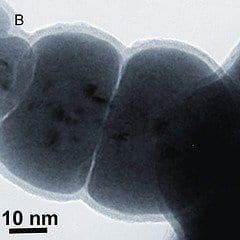
New method could help to reconnect injured organs or build functional human tissues from the ground up
A team of researchers at the Wyss Institute for Biologically Inspired Engineering at Harvard University has found a way to self-assemble complex structures out of bricks smaller than a grain of salt. The self-assembly method could help solve one of the major challenges in tissue engineering: regrowing human tissue by injecting tiny components into the body that then self-assemble into larger, intricately structured, biocompatible scaffolds at an injury site.
The key to self-assembly was developing the world’s first programmable glue. The glue is made of DNA, and it directs specific bricks of a water-filled gel to stick only to each other, the scientists report in the September 9th online issue of Nature Communications.
“By using DNA glue to guide gel bricks to self-assemble, we’re creating sophisticated programmable architecture,” says Peng Yin, Ph.D., a Core Faculty member at the Wyss Institute and senior coauthor of the study, who is also an Assistant Professor of Systems Biology at Harvard Medical School. This novel self-assembly method worked for gel bricks from as small as a speck of silt (30 microns diameter) to as large as a grain of sand (1 millimeter diameter), underscoring the method’s versatility.
The programmable DNA glue could also be used with other materials to create a variety of small, self-assembling devices, including lenses, reconfigurable microchips, and surgical glue that could knit together only the desired tissues, said Ali Khademhosseini, Ph.D., an Associate Faculty member at the Wyss Institute who is the other senior coauthor of the study.
“It could work for anything where you’d want a programmable glue to induce assembly of higher-order structures, with great control over their final architecture — and that’s very exciting,” said Khademhosseini, who is also an Associate Professor at Harvard-MIT’s Division of Health Sciences and Technology (HST), Brigham and Women’s Hospital, and Harvard Medical School.
To fabricate devices or their component parts, manufacturers often start with a single piece of material, then modify it until it has the desired properties. In other cases, they employ the same strategy as auto manufacturers, making components with the desired properties, then assembling them to produce the final device. Living organisms fabricate their tissues using a similar strategy, in which different types of cells assemble into functional building blocks that generate the appropriate tissue function. In the liver, for example, the functional building blocks are small tissue units called lobules. In muscle tissue, the functional building blocks are muscle fibers.
Scientists have tried to mimic this manufacturing strategy by developing self-assembling systems to fabricate devices. For example, last year Yin and his team reported in Science that they had developed miniscule “DNA bricks” smaller than the tiniest virus that self-assemble into complex nanoscale 3D structures.
Now, he and Khademhosseini sought to create a similar programmable, self-assembling system for mesoscale components — those with edge widths ranging from 30 microns to 1000 microns (1 millimeter). They focused first on creating a system in which bricks of biocompatible, biodegradable gels called hydrogels self-assemble into complex structures. For future applications, small hydrogel bricks containing human cells could potentially be injected into the body. The bricks would assemble, then the cells would knit together to form functional tissue as the hydrogels break down.
In previous attempts to self-assemble hydrogel bricks into complex structures, scientists faced a challenge: the bricks often glom onto one another rather than assembling into the desired architecture. Yin and Khademhosseini needed a way to help each component stick only to specific partners, but not to other components. In other words, they needed programmable glue.
“Designing a strategy that leverages the power of self assembly used by living systems to direct construction of tissues from tiny component parts represents an entirely new approach for tissue engineering,” said Don Ingber, M.D., Ph.D., the Wyss Institute’s Founding Director. “Peng and Ali have created an elegant and straightforward method that could permit tissues to be reconstructed from within after a simple injection, rather than requiring major surgery.”
The Latest Bing News on:
Programmable glue
- The best MacBook accessories for 2024on April 25, 2024 at 2:00 am
Here are the accessories we use and recommend to improve the ergonomics, connectivity and overall productivity of your MacBook.
- Fully Adjustable Gating System Reduces Cartoner Changeover Timeon April 23, 2024 at 2:30 pm
At the 2024 Craft Brewer Conference, held at the Venetian Expo in Las Vegas, Nev., Econocorp, a provider of cartoning and case packing equipment unveiled its latest technology on its Spartan Beverage ...
- Eco Homes: 8 of the Most Sustainable Features to Consider, According to Expertson April 19, 2024 at 5:00 pm
The shape and size of your roof can also constitute effective passive design. Adding a large overhang allows light into your home during wintertime because the sun is at a higher angle, says Rodriguez ...
- Here's What Not To Use When Cleaning Stuck-On Foods From Your Air Fryeron April 15, 2024 at 1:30 pm
Nonstick doesn't really mean nothing will stick! Cheese, sugary marinades, and other spills can cook onto the surface and become challenging to clean.
- Handymen Swear By These Cheap Tricks To Make Your Home Look Better & Save You Moneyon December 20, 2023 at 4:45 pm
A super-adhesive backing ensures a firm, durable bond after cleaning the surface. With resistance to various elements like moisture, sun, temperature, and chemicals, it effectively protects pipes from ...
The Latest Google Headlines on:
Programmable glue
[google_news title=”” keyword=”programmable glue” num_posts=”10″ blurb_length=”0″ show_thumb=”left”]
The Latest Bing News on:
Programmable DNA glue
- Researchers create first artificial, modifiable cells with programmable DNAon April 24, 2024 at 8:08 am
The achievement holds significant promise for advancements in regenerative medicine, drug delivery methods, and diagnostic technologies.
- Beyond biology: Creating dynamic synthetic cells with programmable DNAon April 22, 2024 at 4:59 pm
To do this, they used a new programmable peptide-DNA technology that directs peptides, the building blocks of proteins, and repurposed genetic material to work together to form a cytoskeleton. DNA ...
- Monte Rosa Therapeutics Inc GLUEon April 21, 2024 at 5:00 pm
Morningstar Quantitative Ratings for Stocks are generated using an algorithm that compares companies that are not under analyst coverage to peer companies that do receive analyst-driven ratings ...
- How Much Does It Cost To Install A Thermostat?on April 18, 2024 at 4:33 am
Installing one thermostat will be less expensive than installing multiple units. For manual and programmable thermostats, multiple units must be installed for zoning. With smart thermostats ...
- Nathan Derron April 17, 2024 at 1:37 pm
Derr ND*, Goodman BS*, Jungman R, Leschziner AE, Shih WM, Reck-Peterson SL. (2012) Tug of War in Motor Protein Ensembles Revealed with a Programmable DNA Origami Scaffold. Science 338, 662-665.
- Neuroscientists Discover Shapeshifting DNA Controls Memory Formationon April 17, 2024 at 9:16 am
Neuroscientists have uncovered a new mechanism for memory formation, and it involves changes in the structure of your DNA. If you were asked to picture a molecule of DNA, chances are you would ...
- Dog DNA tests are on the rise—but are they reliable?on April 2, 2024 at 4:59 pm
Is your new shelter pup part beagle or boxer? Many pet owners seek answers to these questions, and as a result, direct-to-consumer dog DNA testing is booming. But how reliable are dog DNA tests ...
- Intelligent liquid: Researchers develop metafluid with programmable responseon April 2, 2024 at 4:59 pm
Researchers from the Harvard John A. Paulson School of Engineering and Applied Sciences (SEAS) have developed a programmable metafluid with tunable springiness, optical properties, viscosity and ...
- No, DNA fragments in COVID-19 vaccines aren't linked to 'major safety concerns' | Fact checkon March 29, 2024 at 11:22 am
A March 16 Instagram post (direct link, archive link) shares a news report about a warning issued by the Florida surgeon general of purported risks associated with DNA fragments in COVID-19 mRNA ...
- Coming soon: A programmable army of humanoid robotson March 14, 2024 at 2:07 am
"So you need all the robots charged up and ready to go by 3 p.m," he says, "but you also have this body of work that needs to get done from 8 a.m. to 11 a.m." With Agility Arc, "you can ...
The Latest Google Headlines on:
Programmable DNA glue
[google_news title=”” keyword=”programmable DNA glue” num_posts=”10″ blurb_length=”0″ show_thumb=”left”]




